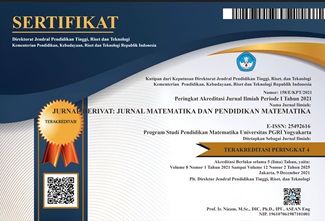Strategi Kontruktif Dan Dekonstruktif: Proses Identifikasi Pola Bilangan Mahasiswa Calon Guru SD
DOI:
https://doi.org/10.31316/j.derivat.v7i2.1071Abstract
This study aims to describe the process of identifying elementary student teacher candidates using constructive and deconstructive strategies. This study's research subjects were 6th-semester PGSD students of Mataram University who attended elementary mathematics learning courses. This type of research is a descriptive study with a qualitative approach. Data collected in the form of test results about patterns and interviews. Then the data is analyzed. The results of the data analysis showed that there was no difference between the process of identifying student patterns using either constructive or deconstructive strategies. The process carried out by students is seeing the shape of the image compiler, making rules for each image, then determining the next pattern rules based on the rules that have been made previously in each image.
Keywords: pattern identification, constructive strategy, deconstructive strategy, figural patternReferences
Barbosa, dkk. (2007). The influence of visual strategies in generalization: a study with 6th grade students solving a pattern task. Proceedings of the Fifth Congress of the European Society for Research in Mathematics Education, 2007, pp. 844-851
Barbosa, dkk. (2012). Pattern Problem Solving Tasks As A Mean To Foster Creativity In Mathematics. Proceedings of the 36th Conference of the International Group for the Psychology of Mathematics Education, Vol. 4, 171-178. Taipei, Taiwan: PME.
Hourigan, A., & Leavy, A. (2015). What ’ s the Rule ? APMC, 20(4), 31–39.
Lithner, J. (2017). Principles for designing mathematical tasks that enhance imitative and creative reasoning. ZDM - Mathematics Education, 49(6), 937–949. https://doi.org/10.1007/s11858-017-0867-3
Moleong, L. J. (2006). Metode Penelitian Kualitatif. Remaja Rosda.
Montenegro, P., Costa, C., & Lopes, B. (2018). Transformations in the Visual Representation of a Figural Pattern. Mathematical Thinking and Learning, 20(2), 91–107. https://doi.org/10.1080/10986065.2018.1441599
Nurmawanti, Iva; Bambang, E.I; Sulandra, M. I. (2016). Identifikasi Pola Siswa SMP Berdasarkan Teori Gestalt. Jurnal Pembelajan Matematika, III(2), 154 – 161.
Nurmawanti, I., & Sulandra, I. M. (2020). Exploring o f Student ’ s Algebraic Thinking Process Through Pattern Generalization using Similarity or Proximity Perception. 9, 191–202.
Rivera, F. D. (2018). Pattern generalization processing of elementary students: Cognitive factors affecting the development of exact mathematical structures. Eurasia Journal of Mathematics, Science and Technology Education, 14(9). https://doi.org/10.29333/ejmste/92554
Rivera, F. D., & Becker, J. R. (2008). Middle school children’s cognitive perceptions of constructive and deconstructive generalizations involving linear figural patterns. ZDM - International Journal on Mathematics Education, 40(1), 65–82. https://doi.org/10.1007/s11858-007-0062-z
Samson, D. (2012). Pictorial pattern generalisation: Tension between local and global visualisation. Pythagoras, 33(3), 1–9. https://doi.org/10.4102/pythagoras.v33i3.172
Setiawan, Y. E., Purwanto, Parta, I. N., & Sisworo. (2020). Generalization strategy of linear patterns from field-dependent cognitive style. Journal on Mathematics Education, 11(1), 77–94. https://doi.org/10.22342/jme.11.1.9134.77-94
Tanişlf, D., & Õzdaş, A. (2009). The strategies of using the generalizing patterns of the primary school 5th grade students. Kuram ve Uygulamada Egitim Bilimleri, 9(3), 1485–1497.
Downloads
Published
Issue
Section
Citation Check
License
Authors who publish with this journal agree to the following terms:
-
Authors retain copyright and grant the journal right of first publication with the work simultaneously licensed under a Creative Commons Attribution-ShareAlike 4.0 International License that allows others to share the work with an acknowledgment of the work's authorship and initial publication in this journal.
- Authors are able to enter into separate, additional contractual arrangements for the non-exclusive distribution of the journal's published version of the work (e.g., post it to an institutional repository or publish it in a book), with an acknowledgment of its initial publication in this journal.
- Authors are permitted and encouraged to post their work online (e.g., in institutional repositories or on their website) prior to and during the submission process, as it can lead to productive exchanges, as well as earlier and greater citation of published work (See The Effect of Open Access).







